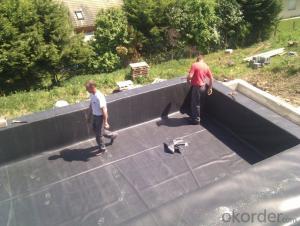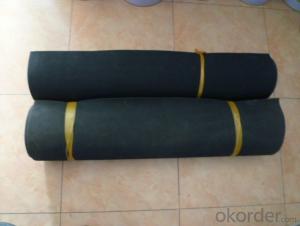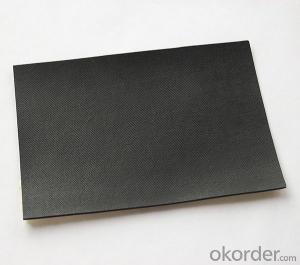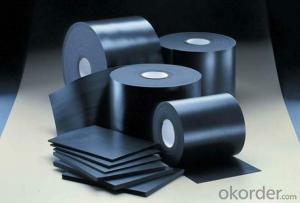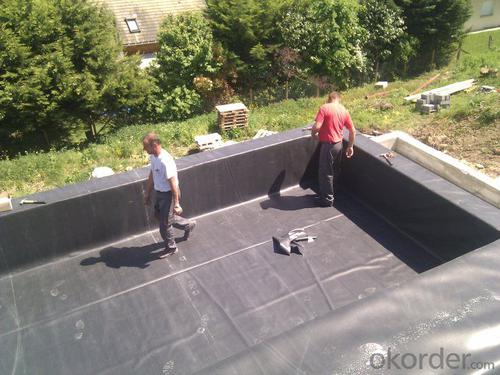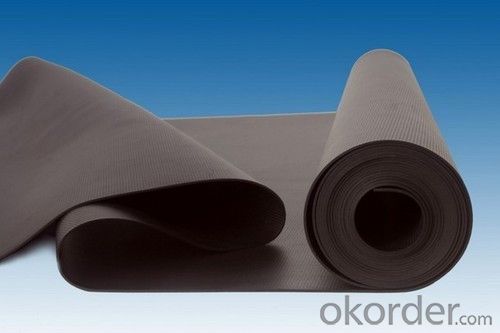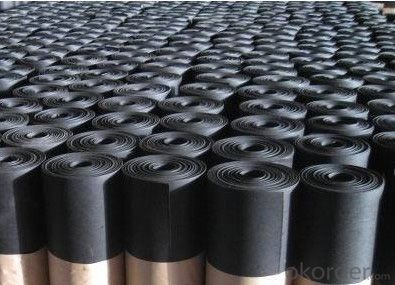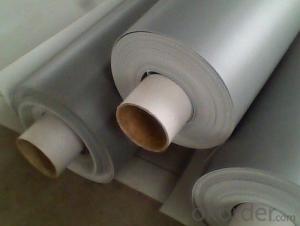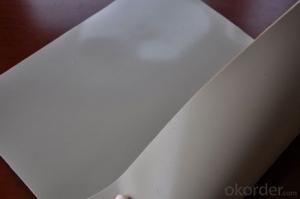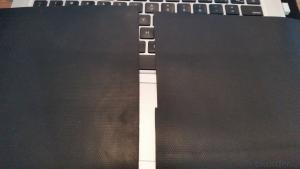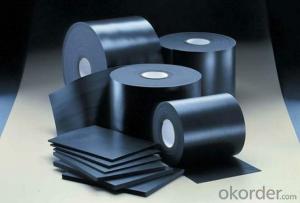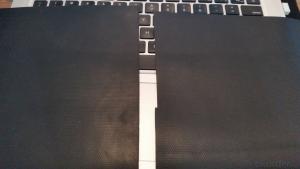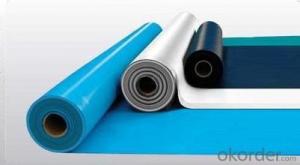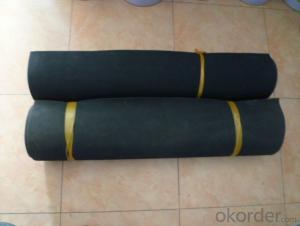EPDM Waterproof Membrane with 1.0mm for Basement Project
- Loading Port:
- Shanghai
- Payment Terms:
- TT OR LC
- Min Order Qty:
- 20000 m²
- Supply Capability:
- 5000000 m²/month
OKorder Service Pledge
OKorder Financial Service
You Might Also Like
EPDM Waterproof Membrane with 1.0mm for Basement Project
Description Of EPDM Waterproof Membrane with 1.0mm for Basement Project:
1. EPDM waterproof membrane is made from ternary ethylene-propylene rubber, which is for waterproofing of exposed and non-exposed applications.
2. EPDM waterproof membrane production adopts the world-advanced equipment of cold feeding extrusion and continuous vulcanization technology.
3. EPDM waterproof membrane is of high elasticity among high polymer waterproof materials and becomes a world-popular waterproofing material.
Main Features of EPDM Waterproof Membrane with 1.0mm for Basement Project:
1.Excellent anti aging performance ,service life up to 50 years.
2.High extension rate,high tensile strength ,small size changes at heat treatment.
3.Good plant roots penetrability resistance and can be made waterproofing layer of planting roof.
4.Special modified molecular structure ,effectively resolving the current domestic and foreign glue joint problem.
5.Good low temperature flexibility ,and good performance of adapting to ambient temperature changes.
6.Convenient application ,solid joint ,no environment pollution.
7.Chemical corrosion resistance ,can be used for special occasions.
8.Good anti-perforated.
Specifications of EPDM Waterproof Membrane with 1.0mm for Basement Project:
| Material | EPDM Rubber |
| Size | 1.2m (width)*20m (length) or customized, weldable type 2.05m or 4m width |
| Thick | 1.2mm, 1.5mm, 2.0mm |
| Type | Vulcanized & Weldable |
| Pattern | Non-reinforced (homogeneous) |
| Certificate | ISO9001/14001 |
Applications of EPDM Waterproof Membrane with 1.0mm for Basement Project:
1. Roofs, Basement, Toilet
2. Industrial and civil building waterproofing
3. Geo-synthetic liner for swimming pool, channels, irrigation system
4. Especially suit for projects with high requirements in durability, anti-corrosion and deformation

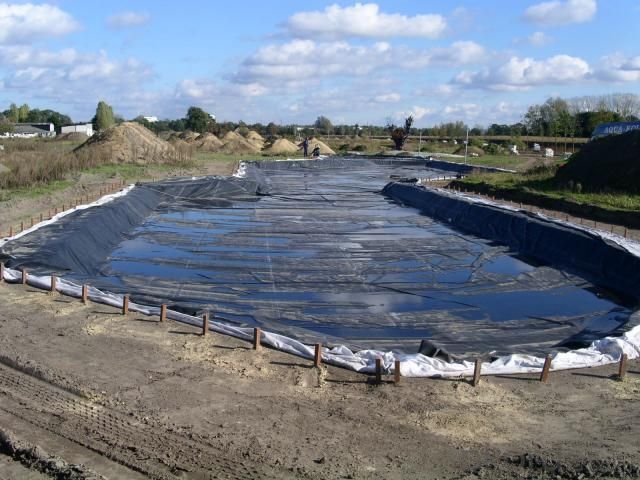

IMages of EPDM Waterproof Membrane with 1.0mm for Basement Project:




FAQ of EPDM Waterproof Membrane with 1.0mm for Basement Project:
1. What are we supplying?
We are specialized in producing Colorful Asphalt Roof Shingle, SBS/APP modified bitumen waterproof membrane, Self adhesive bitumen waterproof membrane, PVC waterproofing membrane, EPDM rubber roofing membrane, Single Component Polyurethane Waterproof Coating, and Spray Polyurea Waterproof Coating
.
2. How Many years experience do we have?
We have been exported to more than 20 countries in the past 15 years.
3. How long do we usually reply your request?
We always reply our customer within 24 hours.
- Q: Are there any specific installation requirements for waterproofing membranes?
- Yes, there are specific installation requirements for waterproofing membranes. These requirements may vary depending on the type of membrane being used, but there are some general guidelines that apply to most installations. Firstly, it is important to properly prepare the surface that the membrane will be applied to. This may involve cleaning the surface, removing any loose debris or previous coatings, and ensuring the surface is smooth and free from any irregularities. This step is crucial as it allows for better adhesion between the membrane and the surface. Next, the membrane should be applied according to the manufacturer's instructions. This typically involves using a suitable adhesive or bonding agent to adhere the membrane to the surface. It is important to follow the recommended application rate and ensure that the membrane is applied evenly and without any air bubbles or wrinkles. In addition to proper application, it is also important to pay attention to the seams and joints of the membrane. These areas are particularly vulnerable to water penetration, so they should be carefully sealed using an appropriate sealant or tape. This ensures a watertight seal and prevents any water from seeping through the seams. Lastly, it is important to protect the installed membrane from any damage during and after installation. This may involve covering the membrane with a protective layer, such as a geotextile fabric or a layer of soil, to prevent punctures or tears. Additionally, any construction or landscaping work that may occur after the installation should be done with caution to avoid damaging the membrane. Overall, the specific installation requirements for waterproofing membranes will depend on the type of membrane being used and the specific conditions of the project. It is always recommended to consult the manufacturer's instructions and guidelines to ensure proper installation and long-lasting waterproofing performance.
- Q: Can a waterproofing membrane be used on precast lead surfaces?
- Yes, a waterproofing membrane can be used on precast lead surfaces. The membrane provides an additional layer of protection against water penetration, helping to prevent leaks and moisture damage on the precast lead surfaces.
- Q: Can a waterproofing membrane be installed on vertical surfaces without causing sagging or drooping?
- Installing a waterproofing membrane on vertical surfaces without causing sagging or drooping is possible. The key lies in ensuring proper installation techniques and the use of suitable materials. To begin with, it is crucial to choose a high-quality waterproofing membrane designed specifically for vertical applications. These membranes are typically more rigid and offer better adhesion properties, enabling them to firmly adhere to vertical surfaces without sagging. Next, surface preparation plays a vital role in establishing a strong bond between the membrane and the vertical surface. It is important to thoroughly clean the surface, removing any debris, and properly prime it before applying the membrane. This step creates a solid foundation for the membrane and prevents any potential sagging or drooping. In addition, it is essential to follow proper installation techniques. Applying the membrane smoothly and evenly, without excessive stretching or folding, is key to avoiding sagging. Moreover, any seams or overlaps in the membrane should be carefully sealed to maintain a watertight barrier. Furthermore, it is recommended to use mechanical fixings like screws or nails to secure the membrane in place. These fixings provide additional support and help prevent sagging over time. In conclusion, by selecting the right materials, properly preparing the surface, and employing careful installation techniques, it is possible to install a waterproofing membrane on vertical surfaces without causing sagging or drooping.
- Q: Are there any drawbacks or limitations to using a waterproofing membrane?
- Yes, there are some drawbacks and limitations to using a waterproofing membrane. One limitation is that the installation process can be time-consuming and labor-intensive. Waterproofing membranes often require careful surface preparation and multiple layers, which can be time-consuming and may require skilled labor. This can increase the overall cost of the project. Another limitation is that waterproofing membranes may not be suitable for all surfaces. Some membranes are designed specifically for certain types of substrates, such as concrete or metal, and may not adhere properly to other materials. It is important to select the appropriate type of membrane for the specific surface to ensure proper adhesion and effectiveness. Additionally, waterproofing membranes can be sensitive to environmental conditions. Extreme temperature fluctuations, UV exposure, and chemical exposure can degrade the membrane over time, reducing its effectiveness. Regular inspections and maintenance may be required to ensure the longevity of the membrane. Furthermore, waterproofing membranes can be susceptible to damage during installation or from external factors such as foot traffic or heavy objects. Punctures, tears, or improper installation can compromise the integrity of the membrane and reduce its ability to prevent water infiltration. Lastly, waterproofing membranes may not completely prevent water penetration in certain situations. For example, if there are existing cracks or structural issues in the substrate, water may still find a way to seep through, bypassing the membrane. It is important to address any underlying structural issues before applying the membrane to ensure optimal performance. Overall, while waterproofing membranes offer many benefits in terms of protecting against water damage, it is crucial to consider these limitations and drawbacks to make an informed decision about their use in specific applications.
- Q: Can a waterproofing membrane be used in below-grade applications?
- Yes, a waterproofing membrane can be used in below-grade applications. Waterproofing membranes are often used in construction to prevent water penetration and leakage in below-grade areas such as basements or foundations. These membranes create a barrier that keeps water out, helping to protect the structure from water damage and moisture-related issues.
- Q: Can a waterproofing membrane be used on tunnels with fire protection systems?
- Yes, a waterproofing membrane can be used on tunnels with fire protection systems. In fact, it is often recommended to use a waterproofing membrane in conjunction with fire protection systems in tunnels to provide an additional layer of protection. The waterproofing membrane helps to prevent water infiltration into the tunnel, which can potentially damage the fire protection systems and compromise their effectiveness. By ensuring that the tunnel is watertight, the waterproofing membrane helps to maintain the integrity and functionality of the fire protection systems, allowing them to perform their intended function in case of fire. Additionally, the waterproofing membrane can also help to prevent the spread of fire by acting as a barrier against the passage of flames and smoke. However, it is important to ensure that the selected waterproofing membrane is compatible with the specific fire protection systems being used in the tunnel to ensure optimal performance and safety.
- Q: Can a waterproofing membrane be used for outdoor applications?
- Outdoor applications can indeed benefit from the use of a waterproofing membrane. Their primary purpose is to shield against water and moisture infiltration, making them well-suited for outdoor settings where exposure to rain, snow, and other weather elements is a concern. These membranes find extensive use in various outdoor areas, including roofs, balconies, decks, and foundations, as they effectively protect against water damage and ensure long-term durability. They form a reliable barrier that keeps water out while still allowing the structure to breathe, preventing the accumulation of moisture and potential problems like mold and rot. Ultimately, utilizing a waterproofing membrane for outdoor applications is a wise decision that enhances the structure's longevity and performance.
- Q: Are waterproofing membranes resistant to acid rain?
- Waterproofing membranes, in general, exhibit resistance against acid rain. These membranes are designed to create a barrier against the infiltration of water and are typically constructed using materials that can withstand various environmental factors, including acid rain. Acid rain is formed when water vapor in the atmosphere reacts with sulfur dioxide and nitrogen oxide pollutants, resulting in the production of sulfuric and nitric acids. Over time, these acids can corrode and harm certain materials. However, waterproofing membranes are engineered with the specific purpose of enduring acid rain and other environmental pressures. They are commonly composed of materials like modified bitumen, thermoplastic polyolefin (TPO), ethylene propylene diene monomer (EPDM), or polyvinyl chloride (PVC), which possess a high degree of resistance to acid rain. Furthermore, some waterproofing membranes may incorporate additional protective coatings or additives to enhance their capacity to withstand acid rain, ensuring long-lasting durability and performance. Nevertheless, it is important to bear in mind that the precise level of acid rain resistance of a waterproofing membrane may vary based on the specific product and manufacturer. Consequently, it is always advisable to consult the manufacturer's guidelines or specifications for accurate information.
- Q: Modified asphalt waterproofing membrane SBS I G PE4 What does it mean?
- Waterproof membrane refers to the asphalt or polymer waterproof material impregnated in the carcass, made of waterproof material products, in the form of coil, known as waterproofing membrane.
- Q: Can a waterproofing membrane be used on roofs with solar panels?
- Yes, a waterproofing membrane can be used on roofs with solar panels. In fact, it is highly recommended to use a waterproofing membrane in such cases to ensure that the roof remains watertight and protected from any potential leaks. The waterproofing membrane acts as a barrier that prevents water from seeping into the roof structure and causing damage. It is important to choose a waterproofing membrane that is compatible with the solar panels and does not interfere with their performance. Additionally, proper installation techniques should be followed to ensure a seamless integration of the membrane and solar panels.
Send your message to us
EPDM Waterproof Membrane with 1.0mm for Basement Project
- Loading Port:
- Shanghai
- Payment Terms:
- TT OR LC
- Min Order Qty:
- 20000 m²
- Supply Capability:
- 5000000 m²/month
OKorder Service Pledge
OKorder Financial Service
Similar products
Hot products
Hot Searches
Related keywords
